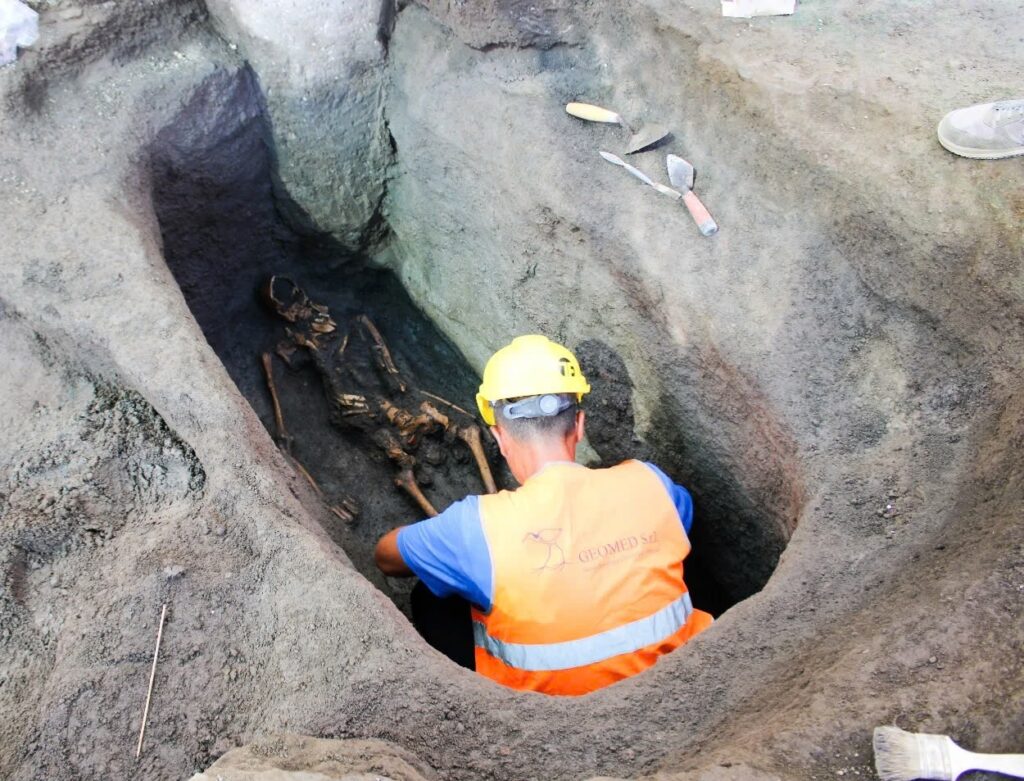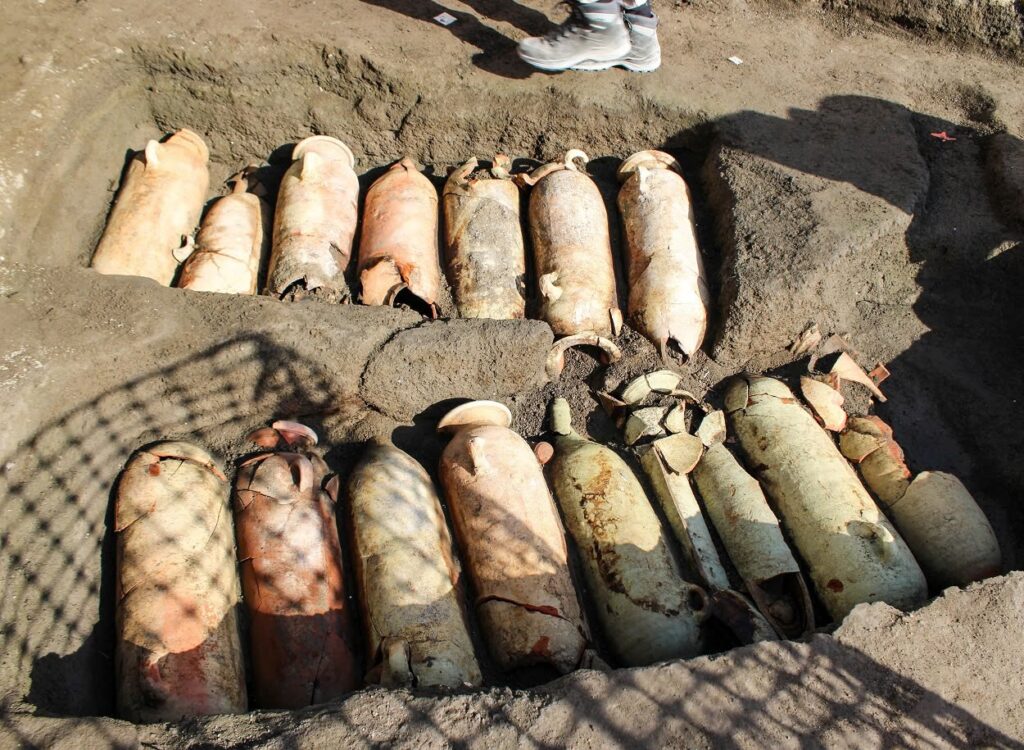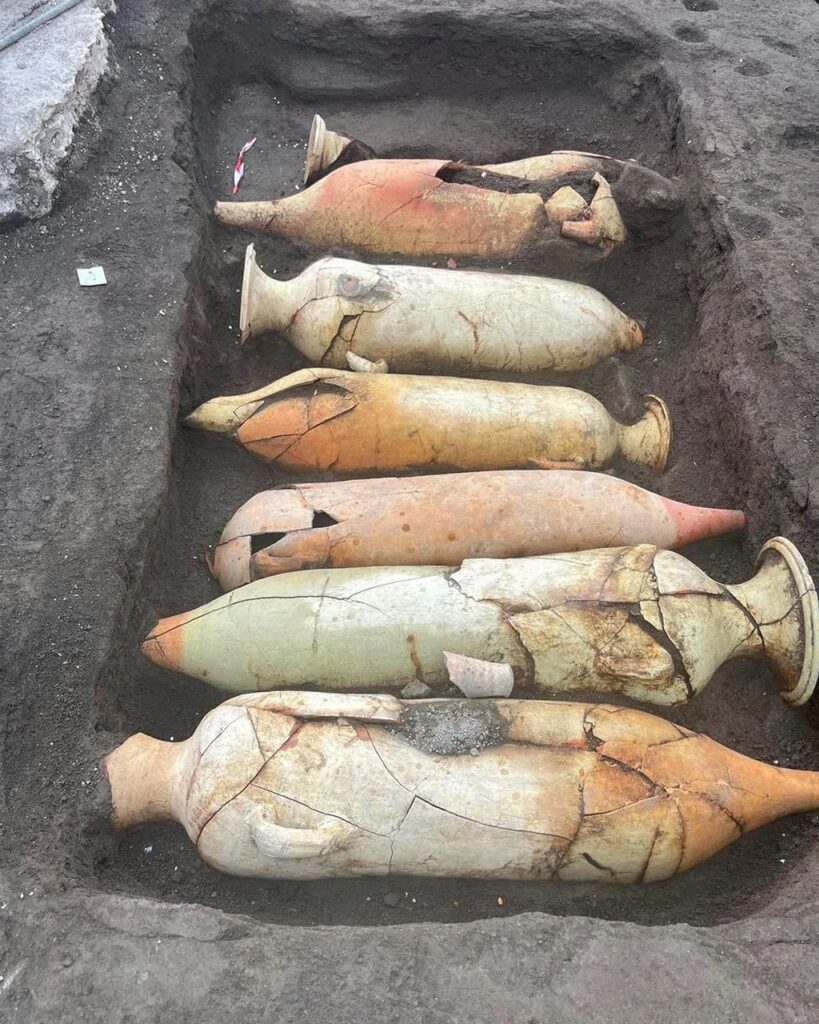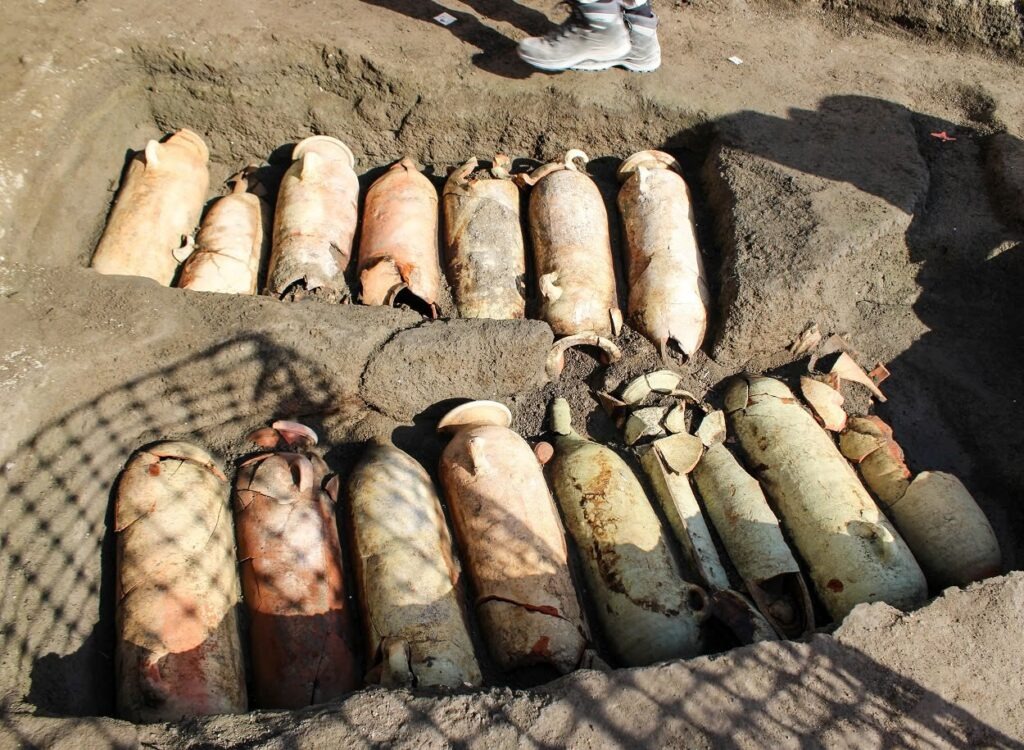Archaeologists working at the eastern edge of Pompeii, Italy’s famously preserved ancient city, have made a series of remarkable discoveries that deepen our understanding of the region before Roman dominance. The finds were made during construction of an underground car-park and other infrastructure work, and offer surprising new evidence of life, death, trade and agriculture in the centuries before the eruption of Mount Vesuvius.
A Necropolis Frozen in Time

The excavation team uncovered a necropolis of approximately 35 earthen pit-burials, dating from the 3rd to the 1st century BC — meaning they precede Pompeii’s full alignment under Roman rule. Each grave was carefully covered with amphorae, the necks and tips alternately arranged, forming symbolic covers over the bodies. The amphorae themselves carry makers’ marks in the Punic language, suggesting North African origins and hinting at far-reaching trade links long before the Romans took full control of the region.
Beneath the surface, the anaerobic water-logged soil conditions have preserved skeletal remains with unusual clarity. Alongside the bones, archaeologists found funerary goods: small ceramic unguentariums used for perfumed oils, coins, and fragments of pottery that shed light on burial rituals at the time. The presence of North-African amphorae suggests these communities engaged in Mediterranean exchange networks earlier than previously documented.
A Canal Rich With History

Nearby, a previously unrecognized canal system — long buried beneath volcanic pumice and later layers — has provided a rich trove of pre-Roman artifacts. The finds include hundreds of tile fragments, pieces of preserved timber, amphorae, dolia (large storage jars), and notably 20 small volcanic-stone columella (pillar-shafts) plus roof-tiles stamped in the Oscan language, a non-Latin Italic tongue. A stone head carved from grey Campanian tufa bearing traces of red paint suggests statuary production or high-status display even in this pre-Roman phase of life.
Together, the canal-adjacent finds show that the area served not only as a burial ground but as a living, working landscape: storage, transport, and craft production all operated here well before the Roman city as we know it emerged.
Fields of the Past
Under layers of Vesuvian pumice, further study revealed an extensive field system, with furrows, planting pits and reservoirs that likely supplied produce to the growing settlement that became Roman Pompeii. Pollen and organic-remains analysis is ongoing, but early signs point to perennial artichoke cultivation and other vegetables suited to the Campanian climate. The discovery recalibrates our understanding: the economy of the region was not simply imposed by Rome, but built on a deep, indigenous agricultural tradition.
A Window Into Pre-Roman Pompeii

These discoveries reshape how we view the long timeline of Pompeii. Rather than emerging suddenly under Roman rule, this was a place with centuries of settled activity, trade connections to Africa, local craft industries, vibrant agriculture and complex burial practices. The necropolis, canal network, and field system articulate a society that already had layers of sophistication when the Romans arrived.
The finds also raise questions: What were the social identities of the people buried in those pit-graves? How did trade with North Africa shape this region long before Rome’s economic domination? And how did local languages, crafts and land-use persist or adapt during Rome’s ascendancy?
Implications for Archaeology and History
For archaeologists, these results underscore the importance of looking beneath the visible Roman layer for contexts that pre-date it. The “Roman Pompeii” narrative has long dominated, but the earlier Italic, Greek, and Punic influences are now coming into clearer focus. As one archaeologist remarked: “We’re not simply uncovering the city destroyed in AD 79 — we’re peeling back generations of change that preceded that moment.”
For historians of trade and cultural interaction, the amphorae with Punic marks signal that Mediterranean networks were far more entwined in the Campania region than assumed. And for specialists in agricultural history, the pre-Roman field systems offer rare data on production techniques, crop choice and land-management practices.
What Might Be Next?
Researchers emphasize that these finds are still preliminary. Carbon-dating of skeletal remains, isotopic analysis of diet, botanical studies of crops, and petrographic studies of amphorae will all refine the picture. One exciting possibility: linking the North African amphorae to specific workshops or ports — which could trace early migration or merchant routes into Italy.
In addition, the spatial relationship between the necropolis, canal and fields invites new approaches: perhaps the area functioned as an integrated suburban zone, supporting the urban centre of Pompeii through burial, production and agriculture. Future excavations will test that model.
Conclusion
In sum, the recent discoveries near Pompeii’s eastern edge offer a richer, more layered history of the site than the familiar story of Roman grandeur and sudden destruction. They trace life, trade, craft and cultivation back into the pre-Roman era, deepening our appreciation for how these landscapes evolved.
The ruins of Pompeii may be frozen in time, but buried beneath them lies another world — one that, layer by layer, is slowly being revealed. As archaeologists continue their work, who knows what other secrets this storied land may yet yield about the civilizations that flourished long before Mount Vesuvius’s deadly eruption.
Sources
-
Archaeology Magazine – Pompeii After Vesuvius: Archaeologists Uncover Centuries-Long Reoccupation
-
The Guardian – People Reoccupied Pompeii after Vesuvius Eruption, Archaeologists Find
-
Le Monde – In Pompeii, New Evidence Shows Signs of Life Post-Eruption
-
The Art Newspaper – Pompeii’s Secret Second Life Revealed by Latest Archaeological Finds
